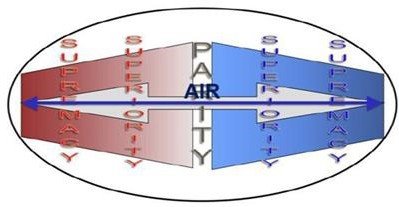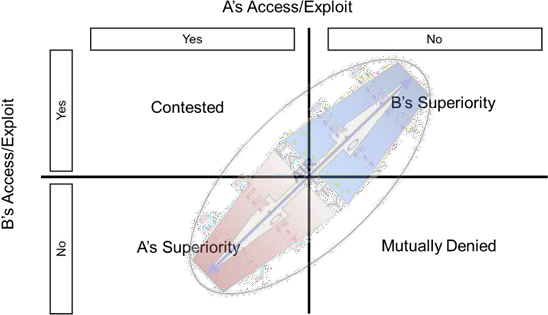Rethinking Air Superiority - Towards an Integrated Framework for Modern Airpower
Kazunobu Sakuma
Japan Air Self-Defence Force
For over a century, the concept of air superiority has underpinned the strategic thought and operational doctrine of modern militaries. Rooted in the belief that control of the skies is a prerequisite for effective operations, this notion has traditionally emphasized achieving uncontested access to airspace early and decisively. Yet, contemporary conflict particularly the war in Ukraine—has disrupted this model, revealing new dynamics where air superiority may never be fully achieved and where denial, parity, and technological innovation define air operations.
This blog outlines the evolution of airpower theory, compares major contemporary perspectives and critiques the limitations of binary thinking on air superiority. To address these limitations, I introduce a new concept, the Two-Parities Model, which expands the linear binary continuum into a multidimensional matrix. I conclude by suggesting an integrated framework for future doctrine and strategy.
Traditional and evolving perspectives on air superiority
Historically, air superiority has been conceptualized as a linear condition: a force either controls the skies or it doesn’t. This view was shaped by 20th-century conflicts like WWII and the Gulf War, where uncontested air dominance enabled freedom of manoeuvre, decisive strikes, and rapid joint force integration. In these scenarios, the emphasis was on platforms (fighters, bombers), kinetic destruction, and offensive tempo.
However, evolving threat environments and emerging technologies have made this model less predictive. The conflict in Ukraine revealed a situation where neither Russia nor Ukraine achieved traditional air superiority. Instead, both employed air denial strategies, including layered air defences, mobile surface-to-air missile (SAM) systems, and extensive use of unmanned aerial vehicles (UAVs). This suggests a need to rethink what constitutes "air control" and to explore more flexible conceptual frameworks.

Comparative analysis of contemporary air power thought
This section compares major contributors to modern air power thought:
- The Classical, Offensive View: Deptula & Bowie (2024) represent a traditionalist school, asserting that achieving air superiority early remains essential. They see denial strategies as insufficient and emphasize high-end platforms and decisive offensive action. Their view reflects the legacy of US air power thinking.
- A Joint-Oriented, Adaptive View: Hecker (2024) and Bowsher (2023) offer a moderate, joint-oriented perspective, focusing on tailored, integrated, and adaptive use of air power. They accept that air superiority may not be achievable or necessary in all scenarios and stress the importance of cross-domain synergy.
- The Air Littoral and Air Denial: Grieco & Bremer (2024) highlight how Ukraine has effectively waged an ‘air denial’ campaign rather than seeking air superiority and has denied Russian aircraft freedom of manoeuvre in much of the operational theatre. They also emphasize that control of the air littoral can enable strategic effects without requiring dominance in traditional airspace.
Comparing these views reveals a spectrum of thinking. Deptula & Bowie (2024) are more offensive and platform-centric, while Grieco & Bremer (2024) are defensive and system-centric. Hecker (2024) and Bowsher (2023) bridge the two by advocating flexibility and jointness. Yet all rely, to some degree, on a binary model of control—air superiority versus denial.
The binary trap — limitations of current paradigms
This section critiques the traditional binary continuum that places air operations on a line from air superiority to air denial. The binary model obscures important operational realities:
- Contested vs. Mutually Denied: Current definitions fail to distinguish between airspace that is contested (where both sides can operate intermittently) and mutually denied (where neither side can exploit the air). This distinction is crucial for campaign design and operational planning.
- Conceptual Blindness: Treating denial as a temporary or undesirable phase dismisses the strategic utility of persistent air denial, which Ukraine has effectively used to prevent Russian dominance.
- Doctrinal Gaps: Planners and theorists are left without the tools to address environments that fall between superiority and denial. The result is a doctrinal blind spot that underestimates hybrid threats and technological adaptation.
Two-Parities Model — a multi-dimensional continuum of air control
To overcome these shortcomings, I propose the Two-Parities Model, which expands the linear binary continuum into a multi-dimensional matrix:
- A’s Superiority: Player A can access and exploit air without severe interruption by player B. Player B is denied access and exploit the air by player A.
- Contested Parity: Both actors intermittently access and exploit the air, often with losses. This resembles many areas of Ukrainian airspace.
- Mutually Denied Parity: Neither side can operate effectively, though access may be possible. In such zones, sustained flight is prohibitively risky. However, UAVs can still play a critical role.
- B’s Superiority: Player B can access and exploit the air without severe interruption by player A. Player A is denied access and exploit the air by player B.

This model clarifies that air control exists in degrees, not absolutes. Figure 2 shows the 2D framework that maps the relationship between access and exploitation—allowing operational planners to assess not just who controls the sky, but how and to what effect.
The Ukraine war provides vivid examples: the use of small UAVs for ISR and strikes under mutual denial, and Ukraine’s layered denial preventing Russian air dominance despite numerical inferiority. The model offers a new lens through which such operations can be understood and anticipated.
Towards an integrated framework for air power doctrine
This section synthesizes the previous insights into a unified analytical framework. The Two-Parities Model offers several benefits:
- Conceptual Integration: It bridges the views of Deptula & Bowie (2024), Hecker (2024), Bowsher (2023), and Grieco & Bremer (2024) by offering a structure that accommodates both offensive and defensive perspectives, kinetic and non-kinetic effects, and the utility of UAVs.
- Flexibility and Planning: The model enables more nuanced campaign planning in ambiguous or degraded air environments, accounting for how limited control can still yield operational effects.
- Beyond Ukraine: Though grounded in Ukraine’s experience, the framework applies to future conflicts involving peer adversaries, A2/AD environments, and coalition warfare where full air superiority may not be achievable or necessary.
By recognizing that mutual denial can be both an intentional strategy and an operational reality, the framework encourages doctrine to move beyond the pursuit of dominance toward a focus on adaptive control and cross-domain leverage.
Conclusion
Air superiority is no longer a binary condition achieved early in conflict and sustained indefinitely. Instead, it must be understood as a dynamic spectrum, shaped by technological evolution, adversary adaptation, and strategic context.
The Two-Parities Model clarifies this complexity by expanding our vocabulary of air control. It captures the reality that contested and mutually denied airspaces demand distinct strategies, capabilities, and expectations. It also underscores how UAVs can reshape access and exploitation, even under conditions previously deemed off-limits.
Most importantly, the model facilitates integration across air power schools of thought, aligning theory with practice. It invites militaries to shed outdated assumptions, rethink operational design, and embrace a more pluralistic, flexible doctrine that reflects the realities of modern war.